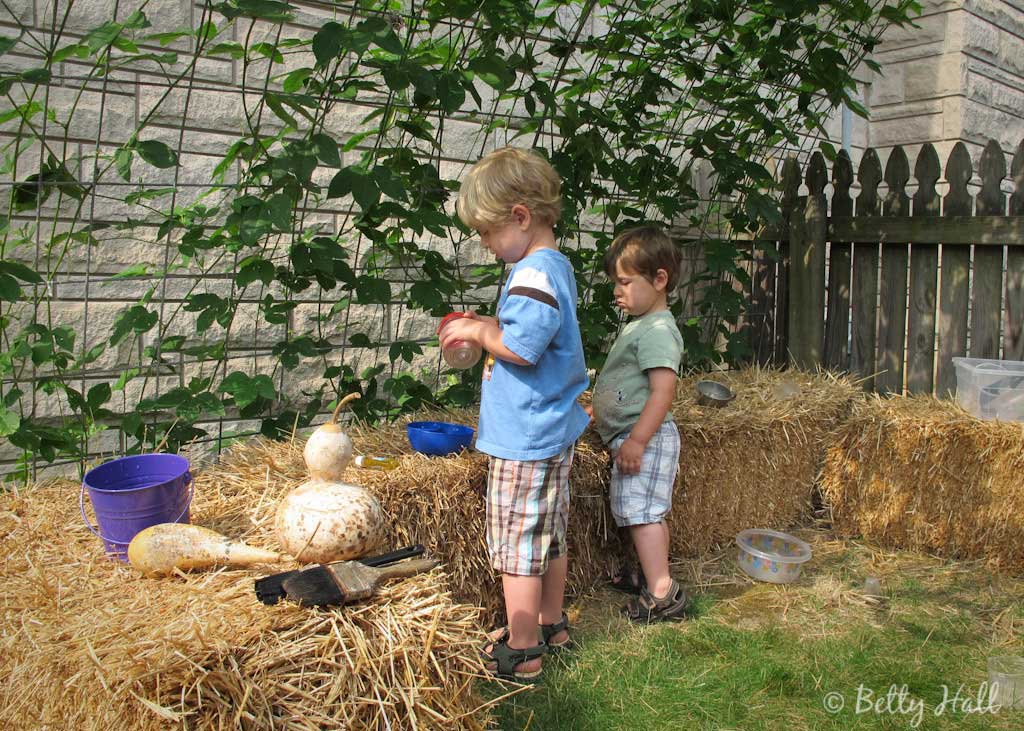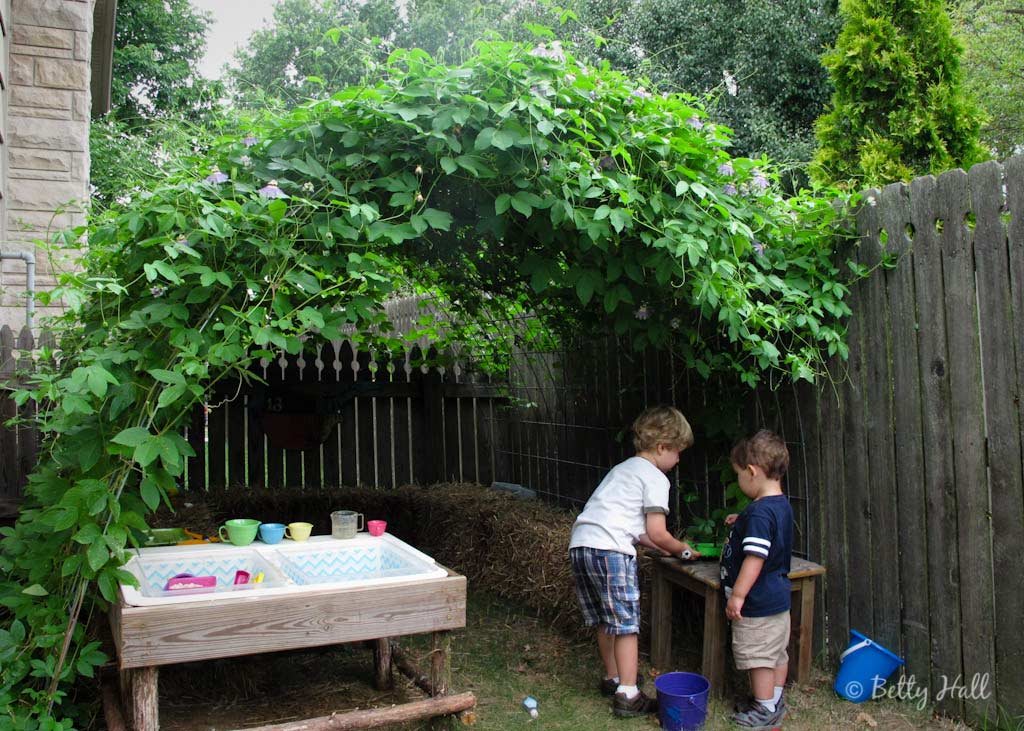After six years, our native passion flower vines (Passiflora incarnata) needed a more substantial trellis. The area where they’re growing wasn’t being used, and I wanted a “hideout” for the neighborhood kids. Our friend Carmen found a creative solution for both. He installed two cattle panels that arch from the base of the passion flower plants to the bottom of our nearby fence. Bales of straw provide seating or a table area.
This was how the hideout looked in June when our neighbors Nicolas and Ben were giving it a try.
Two months later, the arch is thickly covered with vines and blossoms. Carmen also built a neat rustic stand for a double porcelain sink that our friend Connie contributed. One side contains sand, the other contains water, and the sink has proved to be a popular spot.

The vines appear to be quite happy and there is an abundance of the amazing blooms which create a delightful aroma.

I created the hideout primarily for the neighborhood kids, and I like encouraging them to play outdoors. I enjoy it too. It’s a special treat to see youngsters enjoying the hideout and to sometimes be part of their imaginary play.


Hi Betty, I love what you did with your passion vine. I have 2 different varieties that go crazy so I would like to know what cattle panels are and where you got them. I am also absolutely impressed with your photography. The photograph of the passion flower is absolutely gorgeous.
Thanks, Joyce. Carmen bought the cattle panels at Tractor Supply Company. They are also available at Southern States. He put two of them together to get the width we needed. Hope this helps.
Beautiful flower. I had it growing in my yard.
Sara, glad you know first-hand how beautiful this flower is. I think it’s our most exotic native blossom.
I’m curious to know how many vines you planted to make such a lovely bower. When we lived in South Carolina my passion flower vine was very invasive, sprouting up everywhere, from seeds I suppose, and I eventually had to reluctantly remove it. It popped up from cracks in the sidewalk, worked it’s way through the shrubbery and came up in my vegetable and flower gardens. Pretty as it is, I’ve been wary of planting it here in Kentucky because of past experience. Perhaps it’s not so prolific here?
Susan, I think I started out with 3 vines – and they have multiplied during the past 6 years. Passion flower is also quite invasive in Kentucky. I think it spreads from underground runners. I knew that when I planted and deliberately chose a spot not close to any other plants. It still comes up in the nearby grass and when Harry mows the lawn he mows over it so it’s not a problem. It occasionally goes under the fence to my neighbors yard and I pull up the sprouts while they are small. The main plants are along the side of the house and that seems to work OK.
What a wonderful idea! I love it 🙂
Thanks, Judy. It does add interest to the backyard.
What a great idea. It looks like a really fun place to play!
Works well for a cup of tea, as well. Wish you could join me.
I bet the neighborhood kids love you!
I also have passion vine, my 3rd year. Mine pops up everywhere and I let it unless it tries to attach to a plant that I don’t want it to. So many positives, the exotic flower, the bees and butterflies. This is my first year of raising and releasing gulf fritillaries and I have an ample supply of food for them and the variated fritillary with the passion vine ; )
Love your trellis!
Christine, glad to know you also enjoy this vine. I also see plenty of bees on the blossoms. However, I haven’t seen any butterflies. We don’t get gulf fritillaries here. I do see variegated fritillaries occasionally and recently found two of their caterpillars that I hope to eventually see emerge as butterflies.
I enjoy our neighborhood kids and it’s fun to share the backyard with them.
I shared this with four primary teachers at the school where I volunteer in the butterfly. If they sound interested, I may suggest a trip to your house to look at the structure, if that is OK with you.
Linda, I’m always glad to share the backyard with anyone who is interested.
What fun! I’m going to drop by for a play date!
Ann, please do!
Even though many years separate Nicholas and Ben’s heavenly hideout from several I loved as a child, I am astonished that your photos capture that blissful existence so beautifully. Not only have you created a lovely area in your yard which I hope you maintain forever but you have given them a gift that will live in their memory even when they are old men. I would like to know if the Passion Flower vine would stand a chance of growing in my yard which is year-round wet even when the surface is scorched by heat and lack of rain. Since I can no longer dig and plant, do you think a simple broadcasting of seeds would work? If not, might it work to start them in a plastic container and, once roots developed, peal it off and just set the plant on top of the soil?
Beth, the passion flower vine is easy to grow – not so easy to contain. The first ones I ever saw were in a ditch in southern Missouri amongst many weeds. It’s a tough plant and I think you would definitely have a good chance of growing it with your soil. I bought small plants to get mine started. Wish I was close enough to share some of our sprouts with you. Scattering seed is certainly worth a try. There are several different kinds of passion flower. The purple native one is Passiflora incarnata.